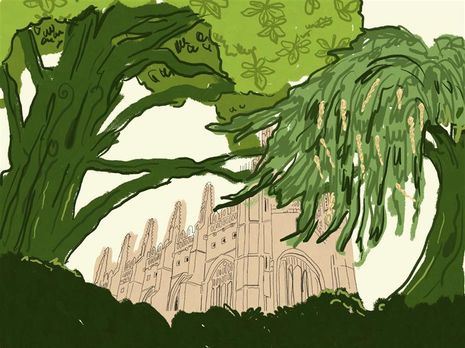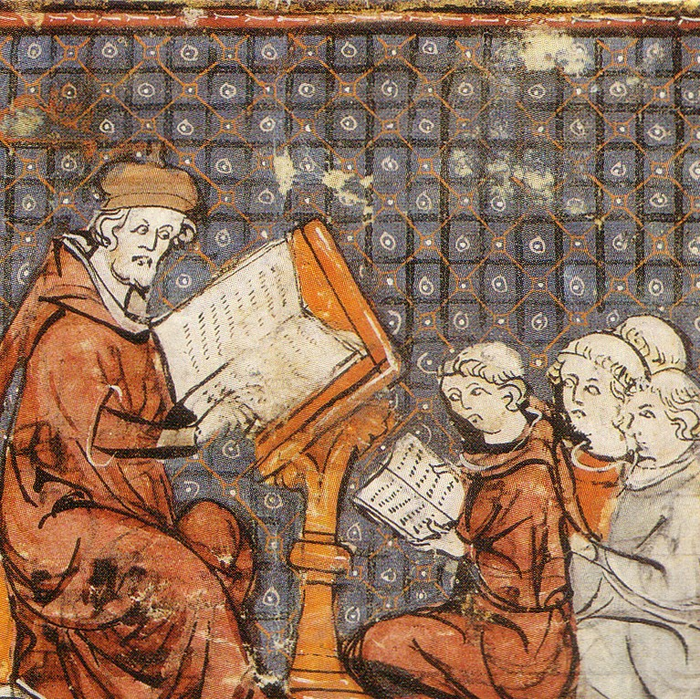College roots: a Cambridge history in trees
Gemini McKee takes a tour through the arboreal history of Cambridge’s colleges

As the fourth-oldest university in the world, few things have had the longevity to watch over the 815 years of Cambridge’s history – but it may be its trees which have seen the most. In a 2004 survey of veteran trees (trees in the final mature stage of their life; often over 100 years old), Cambridge City Council commented that “nothing complements this historic character better than very old trees.” It would be hard to imagine the eastern end of King’s Chapel without its leafy companion, a 150-year-old horse chestnut tree, or picture the backs without its avenues of limes and hornbeams.
Some of Cambridge’s picturesque trees are hard to miss, like the autumnal glory of Darwin’s copper beech, or the red-flowered horse chestnut which dominates Trinity’s New Court – both over 100 years old. Others can be missed among shrub borders, like Pembroke’s Japanese banana plant (which produces bananas, although inedible); or hidden in private gardens or quiet walks, like Queens’ 35-metre-high elm trees – not only the tallest trees in the College, but the tallest elms in the UK. Walking through the courts of Cambridge’s colleges is a green experience, but many of these tourist-proof lawns were once agricultural spaces that provided fruit, vegetables, and herbs for the members. Throughout the medieval period, orchards were essential to the self-sufficiency of colleges like Corpus Christi, Jesus, and Pembroke, to name but a few.
“Murray Edwards students celebrate the harvest of their apples with ‘Apple Day’ on the 23rd October”
Few traces of these old trees remain, although Girton’s Old Orchard has provided fruit, flowers, and shade for the college since 1893. Both Girton and Peterhouse planted an orchard during the second world war as part of the 1940 ‘Dig for Victory’ campaign to combat food shortages. Although Girton’s New Orchard boasts a wide collection of pears, plums, medlars, quinces and cobnuts, its apples won the college gardeners several Royal Horticultural Society prizes in the 60s and 70s. Meanwhile, Murray Edwards students celebrate the harvest of their apples with ‘Apple Day’ on 23 October. Prior to the College’s construction, the site contained the Darwin family home, known as ‘The Orchard’ – true to their pomiculture heritage, Murray Edwards students bring in the autumn by enjoying apple juice and crumble, doing arts and crafts, and listening to live music.
Apples aren’t the only fruit trees cultivated on college land. Several ancient mulberry trees around Cambridge appear to be survivors of a mass planting across England from around 1603. Silkworms feed on mulberry leaves, so King James I supposedly commissioned 10,000 mulberry trees to be planted to increase British silk production. The most famous example is "Milton’s Mulberry" in Christ’s Fellow’s Garden, which might easily be assumed to be planted by the poet himself. However, college records show that the tree was planted in 1609, a year after his birth, so he may just have studied in its shade instead; the tree was named in Milton’s honour around 200 years ago. Although planted during the lifetime of Shakespeare and Cromwell, the ancient tree still produces a crop of mulberries that college kitchen staff turn into jam every year.
“Christ’s ancient tree still produces a crop of mulberries that college kitchen staff turn into jam every year”
Pembroke’s mulberry tree was planted from a cutting of a 17th century tree and is also (misleadingly?) named after a poet alum – Edmund Spenser. Other mulberries from the Stuart era can be found in Queens’ Fellows’ Garden, or the masters’ gardens of Jesus and Corpus Christi. Emmanuel has records of purchasing several mulberries around 1610, but those standing today are Victorian plantings – the originals long gone.
Some of the most famous treescapes in Cambridge are the lime avenues which flank the long drives of river colleges like Trinity and St John’s. Now iconic, the towering lime trees in Trinity have been replaced several times since the first record of an avenue in 1671 – today’s trees are just over 75 years old. Next door, St John’s has a similar avenue of limes which Queen Victoria described as “beautiful” in an 1847 visit to the College. The common lime can grow up to 50 metres tall and live for hundreds of years – perhaps why Downing, Pembroke and Homerton also shade their paths with these trees.
Humanities students will be familiar with the frustratingly root-riddled pavements of Sidgwick Avenue, but the trees which line the street are much older than the lecture site itself. These London plane trees were planted in the Victorian period, not long after the oriental plane tree in Emmanuel’s Fellow’s Garden – perhaps the most famous tree in the University. The huge specimen (its trunk is over 5 metres around) is renowned for its unusual boughs which swoop, coil, and snake along to the ground. During the second world war, Spanish poet Luis Cernuda wrote his poem ‘El Arból’ (The Tree) after spending two years living at Emmanuel. When not providing poetic inspiration, the great tree has also been used as shelter for church fêtes and open-air Shakespeare performances.
“Gardening teams across the university have planted new saplings to succeed the current mature trees”
In 1801, Jesus Fellow Edward Daniel Clarke brought back the seed of an oriental plane tree from the ancient battlefield site of Thermopylae, Greece. A Latin plaque commemorates the tree, which was planted in 1802 and now stands over 25 metres tall in Jesus’s Fellows’ Garden. In 2002, the College celebrated the tree’s 200th birthday on Midsummer’s Day with a jazz band, morris dancers and a children’s drawing competition. Performers sang ‘Largo’ from Handel’s opera about the victorious leader at Thermopylae, Serse; fittingly, Xerxes sings the aria to an oriental plane tree.
Trees have long been the sentinels of Cambridge’s courts, cloisters, and avenues – but unlike marble and stone, they won’t last forever. Many of the University’s ancient trees were removed long ago, like the elm planted by Emmanuel’s first master, Laurence Chaderton. The tree’s remains, then around 300 years old, were removed by a controlled dynamite explosion in 1935. Old trees make way for new buildings – the “exquisitely wreathed” ash tree of Wordsworth’s student days, (mentioned in his poem, ‘The Prelude’), was felled to make way for construction of St John’s’ New Court in 1825. Else, some trees fall to disease or decay, like Wolfson’s pink-flowered Judas tree last year – yet with care, our trees can be preserved for the centuries of Cambridge history to come. In the past 15 years, trees like King’s’ horse chestnut and Darwin’s copper beech have received surgery to protect both the tree’s health and public safety. Moreover, gardening teams across the University have planted new saplings to succeed the current mature trees – as Chaderton said 400 years ago: “We plant for another generation.”
 News / Clare Hall spent over £500k opposing busway 24 December 2025
News / Clare Hall spent over £500k opposing busway 24 December 2025 News / Caius mourns its tree-mendous loss23 December 2025
News / Caius mourns its tree-mendous loss23 December 2025 Comment / The ‘class’ of Cambridge24 December 2025
Comment / The ‘class’ of Cambridge24 December 2025 Comment / Yes, I’m brown – but I have more important things to say22 December 2025
Comment / Yes, I’m brown – but I have more important things to say22 December 2025 Interviews / Politics, your own way: Tilly Middlehurst on speaking out21 December 2025
Interviews / Politics, your own way: Tilly Middlehurst on speaking out21 December 2025









